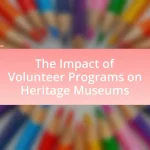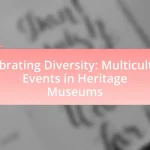Engaging diverse communities in heritage preservation efforts involves the active participation of various cultural, ethnic, and social groups in the decision-making processes that protect and promote their historical and cultural assets. This engagement fosters inclusivity, enhances the relevance of preservation initiatives, and strengthens community ties. The article explores the importance of community engagement, the benefits of involving diverse voices, the challenges faced in participation, and effective strategies for fostering involvement. It also highlights the role of local organizations and technology in enhancing engagement, as well as best practices for sustaining long-term community involvement in heritage preservation.
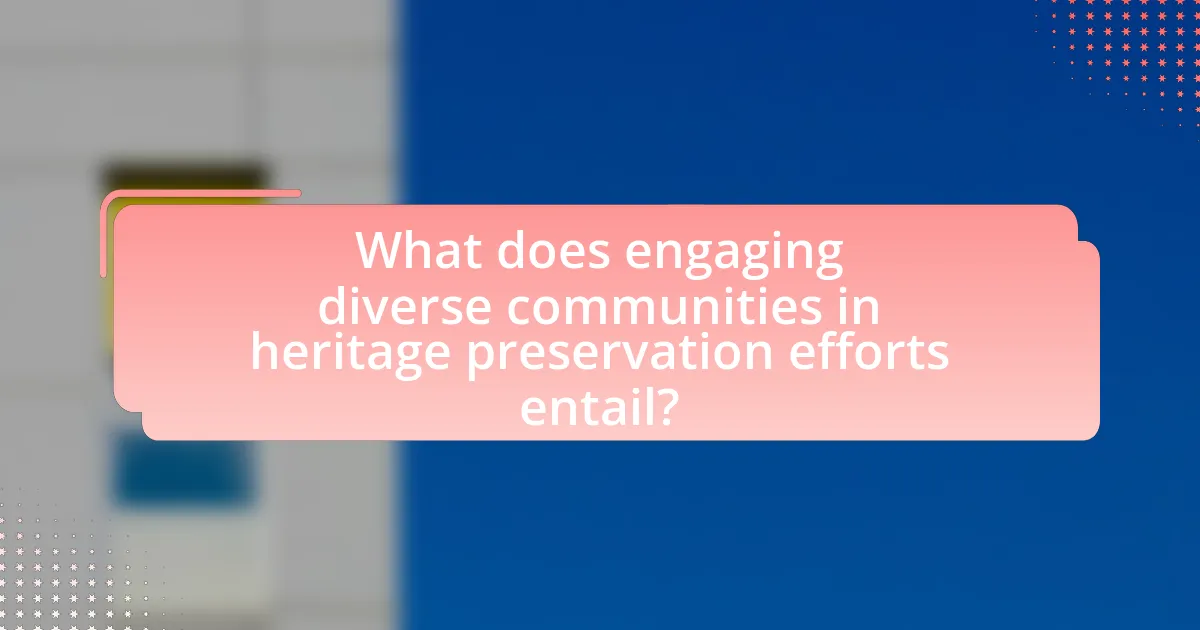
What does engaging diverse communities in heritage preservation efforts entail?
Engaging diverse communities in heritage preservation efforts entails actively involving various cultural, ethnic, and social groups in the decision-making processes related to the protection and promotion of their historical and cultural assets. This engagement fosters inclusivity and ensures that multiple perspectives are considered, which can enhance the relevance and effectiveness of preservation initiatives. For instance, research by the National Trust for Historic Preservation highlights that inclusive practices lead to more sustainable heritage outcomes, as they reflect the values and needs of the communities involved.
Why is community engagement important in heritage preservation?
Community engagement is crucial in heritage preservation because it fosters a sense of ownership and responsibility among local populations. When communities actively participate in preserving their heritage, they contribute valuable knowledge and perspectives that enhance the preservation process. Research indicates that projects involving community input are more likely to succeed, as they reflect the values and needs of the people they serve. For instance, the National Trust for Historic Preservation highlights that community-driven initiatives lead to stronger social ties and increased public support for preservation efforts. This collaborative approach not only protects cultural assets but also empowers communities, ensuring that heritage preservation is relevant and sustainable over time.
What are the benefits of involving diverse communities in these efforts?
Involving diverse communities in heritage preservation efforts enhances cultural representation and fosters inclusivity. This engagement ensures that multiple perspectives and histories are acknowledged, leading to a richer understanding of heritage. Research indicates that projects incorporating diverse voices result in more comprehensive preservation outcomes, as seen in the National Park Service’s initiatives, which emphasize community involvement to reflect the diverse narratives of American history. Additionally, diverse participation can strengthen community ties and promote social cohesion, as evidenced by the success of collaborative projects in urban areas that unite various cultural groups around shared heritage goals.
How does community engagement enhance the preservation process?
Community engagement enhances the preservation process by fostering local ownership and stewardship of cultural heritage. When communities actively participate in preservation efforts, they contribute their unique knowledge, traditions, and values, which enrich the preservation narrative. Research indicates that projects involving community input are more likely to succeed and be sustained over time, as seen in the case of the National Trust for Historic Preservation, which reports that community-driven initiatives lead to increased public support and funding. This collaborative approach not only strengthens the emotional connection to heritage sites but also ensures that preservation efforts reflect the diverse perspectives and needs of the community, ultimately leading to more effective and inclusive outcomes.
Who are the diverse communities involved in heritage preservation?
Diverse communities involved in heritage preservation include indigenous groups, local cultural organizations, ethnic minorities, and academic institutions. Indigenous groups often lead efforts to protect their ancestral lands and cultural practices, as seen in various initiatives across North America and Australia. Local cultural organizations frequently engage in preserving regional traditions and historical sites, while ethnic minorities contribute unique perspectives and practices that enrich the preservation landscape. Academic institutions provide research and resources that support these communities, exemplified by partnerships between universities and local heritage groups to document and preserve cultural heritage.
What types of communities are typically engaged in these efforts?
Communities typically engaged in heritage preservation efforts include indigenous groups, local historical societies, cultural organizations, and urban neighborhoods. Indigenous groups often focus on preserving their ancestral lands and cultural practices, while local historical societies work to maintain historical sites and educate the public about local history. Cultural organizations may promote the arts and traditions of specific ethnic groups, and urban neighborhoods often collaborate to protect their unique architectural heritage and community identity. These communities play a crucial role in ensuring that diverse cultural narratives are recognized and preserved for future generations.
How do cultural backgrounds influence community participation?
Cultural backgrounds significantly influence community participation by shaping individuals’ values, beliefs, and social norms. For instance, communities with strong collectivist cultures often prioritize group activities and communal decision-making, leading to higher engagement in local initiatives. Research indicates that cultural identity fosters a sense of belonging, which enhances participation rates; a study by the Pew Research Center found that individuals who identify strongly with their cultural heritage are more likely to engage in community events and volunteer activities. Additionally, language barriers and differing communication styles can either facilitate or hinder participation, as seen in multicultural neighborhoods where inclusive practices promote broader involvement.
What challenges arise when engaging diverse communities?
Engaging diverse communities presents challenges such as communication barriers, differing cultural values, and varying levels of trust in institutions. Communication barriers arise from language differences and varying literacy levels, which can hinder effective dialogue and understanding. Differing cultural values may lead to conflicting priorities in heritage preservation, as communities may have unique perspectives on what aspects of their heritage are most significant. Additionally, varying levels of trust in institutions can complicate engagement efforts, as some communities may have historical reasons for skepticism towards external organizations. These challenges necessitate tailored approaches to foster meaningful participation and collaboration in heritage preservation efforts.
What barriers do communities face in participating in preservation efforts?
Communities face several barriers in participating in preservation efforts, including lack of funding, limited access to information, and insufficient community engagement. Funding constraints often hinder the ability of communities to initiate or sustain preservation projects, as many rely on grants or donations that may not be readily available. Limited access to information can prevent community members from understanding the significance of their heritage and the processes involved in preservation, leading to disengagement. Additionally, insufficient community engagement can result in a lack of representation and voice in decision-making, further alienating individuals from participating in preservation initiatives. These barriers collectively impede effective involvement in heritage preservation efforts.
How can these challenges be addressed effectively?
To address the challenges of engaging diverse communities in heritage preservation effectively, it is essential to implement inclusive outreach strategies that prioritize community involvement. Research indicates that participatory approaches, such as community workshops and collaborative decision-making, foster a sense of ownership and relevance among diverse groups. For instance, the National Park Service’s “Heritage Preservation Grants” program has successfully engaged various communities by funding projects that reflect local cultural narratives, demonstrating that financial support for community-led initiatives can enhance participation and commitment.
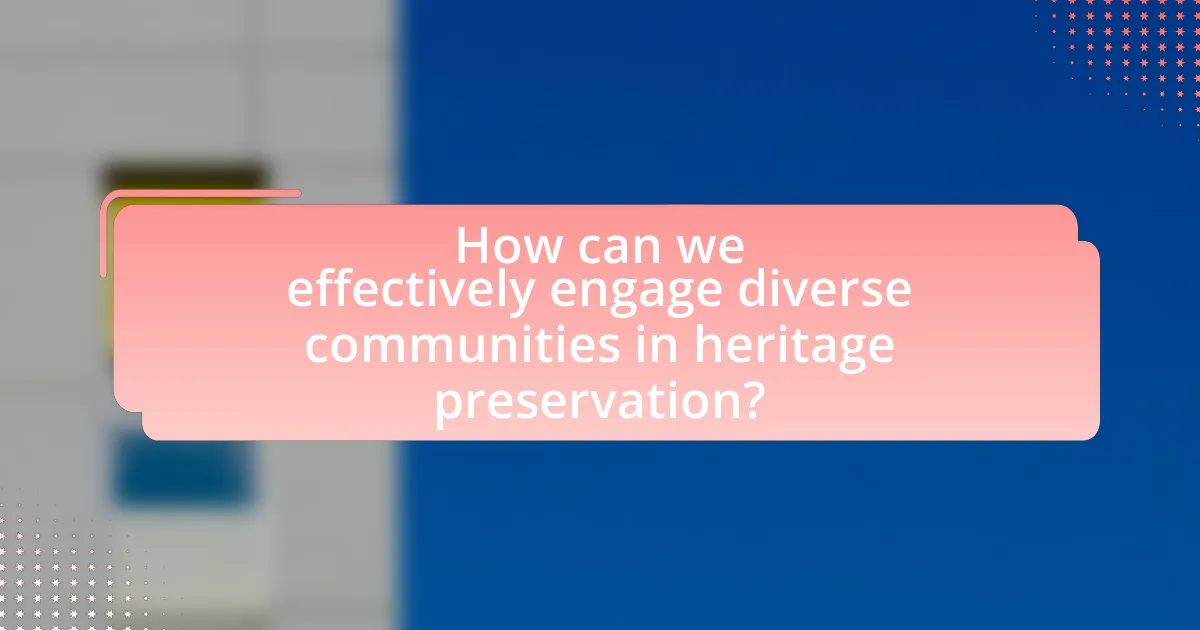
How can we effectively engage diverse communities in heritage preservation?
To effectively engage diverse communities in heritage preservation, it is essential to foster inclusive dialogue and collaboration. This can be achieved by organizing community workshops that invite participation from various cultural groups, ensuring that their voices and perspectives are represented in the preservation process. Research indicates that when communities actively participate, such as in the case of the National Trust for Historic Preservation’s “This Place Matters” campaign, it leads to a stronger sense of ownership and commitment to heritage sites. Additionally, utilizing social media platforms to share stories and experiences related to heritage can enhance engagement and awareness among diverse populations, as evidenced by successful initiatives like the “Heritage Lottery Fund” in the UK, which emphasizes community involvement in heritage projects.
What strategies can be employed to foster community involvement?
To foster community involvement, organizations can implement strategies such as creating inclusive platforms for dialogue, organizing community events, and establishing partnerships with local stakeholders. Inclusive platforms for dialogue, such as town hall meetings or online forums, allow community members to voice their opinions and contribute ideas, thereby increasing engagement. Organizing community events, like workshops or cultural festivals, can also enhance participation by providing opportunities for residents to connect and collaborate on heritage preservation initiatives. Furthermore, establishing partnerships with local stakeholders, including schools, businesses, and non-profits, can leverage resources and expertise, fostering a sense of shared responsibility and commitment to community heritage. These strategies have been shown to enhance community cohesion and increase participation in preservation efforts, as evidenced by successful case studies in various communities across the United States.
How can outreach programs be designed to reach diverse populations?
Outreach programs can be designed to reach diverse populations by incorporating culturally relevant strategies and engaging community stakeholders in the planning process. This approach ensures that the programs resonate with the specific needs and values of various groups, enhancing participation and effectiveness. For instance, research by the Pew Research Center indicates that tailored communication methods, such as using multiple languages and culturally appropriate messaging, significantly improve outreach success among minority communities. Additionally, involving local leaders and organizations in the development of outreach initiatives fosters trust and encourages broader community engagement, as evidenced by successful heritage preservation projects that have utilized this collaborative model.
What role do local organizations play in community engagement?
Local organizations serve as vital connectors in community engagement by fostering relationships between residents and heritage preservation initiatives. They mobilize community members, facilitate dialogue, and provide resources that empower individuals to participate actively in preserving their cultural heritage. For instance, studies show that local organizations often lead workshops and events that educate the community about heritage significance, thereby increasing participation rates in preservation efforts. This engagement is crucial, as it not only enhances community identity but also ensures that diverse voices are represented in the preservation process, ultimately leading to more inclusive and effective heritage initiatives.
How can technology facilitate engagement in heritage preservation?
Technology can facilitate engagement in heritage preservation by providing interactive platforms that allow communities to participate in the documentation and promotion of their cultural heritage. For instance, virtual reality applications enable users to explore historical sites remotely, fostering a deeper connection to their heritage. Additionally, social media campaigns can raise awareness and encourage community involvement in preservation efforts, as evidenced by initiatives like the #SaveHeritage movement, which mobilized thousands to advocate for endangered sites. Furthermore, crowdsourcing platforms allow individuals to contribute data and stories related to local heritage, enhancing collective ownership and engagement in preservation activities.
What digital tools can be used to connect with diverse communities?
Digital tools that can be used to connect with diverse communities include social media platforms, community forums, and collaborative project management software. Social media platforms like Facebook, Twitter, and Instagram facilitate real-time communication and engagement, allowing users to share cultural stories and heritage initiatives. Community forums such as Reddit and specialized platforms like Nextdoor enable localized discussions and foster connections among community members. Collaborative project management software, such as Trello or Slack, supports teamwork and organization in heritage preservation projects, allowing diverse groups to contribute their perspectives and expertise effectively. These tools enhance outreach and participation, making it easier to engage various cultural backgrounds in heritage preservation efforts.
How can social media campaigns enhance community participation?
Social media campaigns can enhance community participation by providing a platform for dialogue, information sharing, and mobilization around heritage preservation efforts. These campaigns facilitate engagement by allowing community members to share their stories, experiences, and cultural heritage, which fosters a sense of belonging and collective identity. For instance, a study by the Pew Research Center found that 69% of adults in the U.S. use social media, making it an effective tool for reaching diverse audiences and encouraging participation in local initiatives. Additionally, social media allows for real-time feedback and interaction, enabling organizations to adapt their strategies based on community input, thus increasing overall involvement in heritage preservation activities.
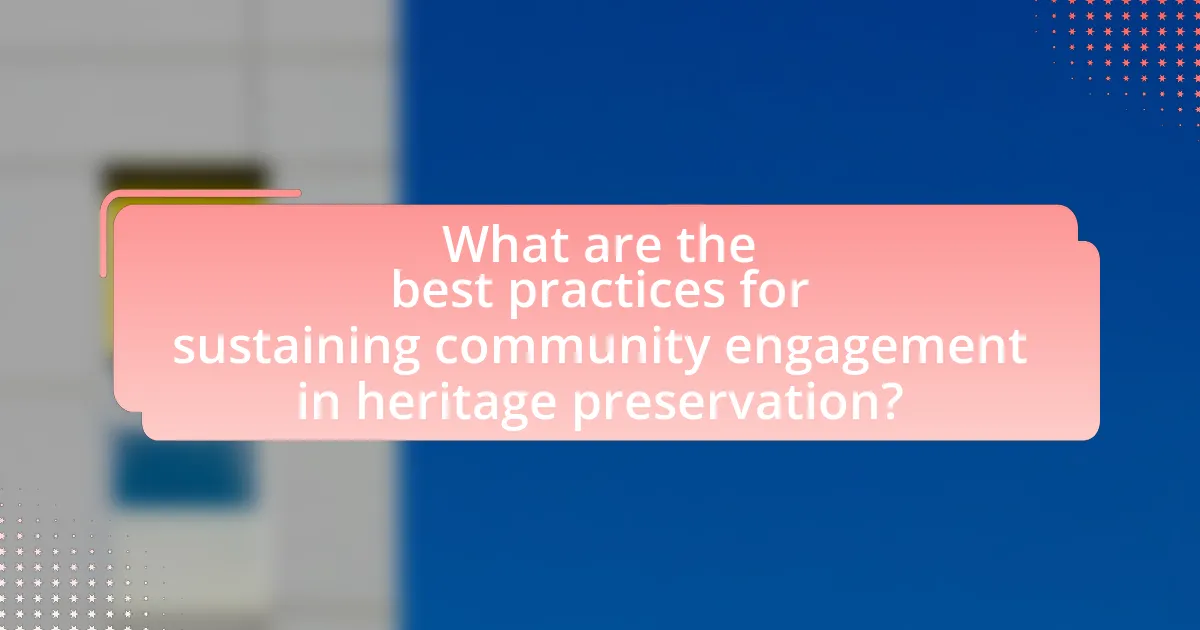
What are the best practices for sustaining community engagement in heritage preservation?
The best practices for sustaining community engagement in heritage preservation include fostering inclusive participation, building partnerships, and providing ongoing education. Inclusive participation ensures that diverse voices are heard, which can be achieved through community forums and outreach programs that invite input from various demographic groups. Building partnerships with local organizations, schools, and cultural institutions enhances resources and support for preservation efforts, as evidenced by successful collaborations in cities like San Francisco, where community-led initiatives have revitalized historic neighborhoods. Ongoing education about the significance of heritage can be facilitated through workshops and events, which have been shown to increase community investment in preservation, as demonstrated by the National Trust for Historic Preservation’s initiatives that engage local residents in learning about their heritage.
How can ongoing relationships with communities be maintained?
Ongoing relationships with communities can be maintained through consistent communication and active involvement in community activities. Establishing regular channels for dialogue, such as community meetings or online forums, fosters trust and transparency. Additionally, involving community members in decision-making processes related to heritage preservation ensures their voices are heard and valued. Research indicates that participatory approaches enhance community engagement, as seen in the case of the National Trust for Historic Preservation, which emphasizes collaboration with local stakeholders to sustain relationships. By prioritizing these strategies, organizations can effectively nurture long-term partnerships with diverse communities.
What methods can be used to gather feedback from community members?
Surveys and questionnaires are effective methods to gather feedback from community members. These tools allow for the collection of quantitative and qualitative data, enabling community organizations to assess opinions, preferences, and concerns regarding heritage preservation efforts. For instance, a study by the National Park Service found that structured surveys can yield insights into community attitudes and engagement levels, facilitating targeted outreach and program development. Additionally, focus groups and community meetings provide platforms for in-depth discussions, allowing participants to express their views and suggestions in a collaborative environment. These methods collectively enhance understanding and foster community involvement in heritage preservation initiatives.
How can success stories be shared to inspire continued involvement?
Success stories can be shared through various platforms such as social media, community newsletters, and local events to inspire continued involvement in heritage preservation efforts. Utilizing social media allows for wide dissemination and engagement, as platforms like Facebook and Instagram can showcase visual narratives and testimonials from community members. Community newsletters can highlight specific achievements and the impact of involvement, fostering a sense of pride and connection among readers. Additionally, organizing local events where success stories are presented can create an interactive environment, encouraging dialogue and further participation. Research indicates that storytelling is a powerful tool in community engagement, as it fosters emotional connections and motivates individuals to contribute to collective goals.
What role does education play in sustaining engagement?
Education plays a crucial role in sustaining engagement by equipping individuals with knowledge and skills necessary for active participation in heritage preservation efforts. Through educational programs, communities gain awareness of their cultural heritage, fostering a sense of identity and belonging. Research indicates that informed individuals are more likely to engage in preservation activities, as they understand the significance of their heritage. For instance, a study by the National Trust for Historic Preservation found that communities with educational initiatives saw a 30% increase in volunteer participation in heritage projects, demonstrating the direct correlation between education and sustained engagement.
How can educational programs be tailored to diverse audiences?
Educational programs can be tailored to diverse audiences by incorporating culturally relevant content, utilizing varied teaching methods, and ensuring accessibility. Culturally relevant content engages participants by reflecting their backgrounds and experiences, which enhances relatability and interest. Varied teaching methods, such as hands-on activities, visual aids, and technology integration, cater to different learning styles, ensuring that all participants can grasp the material effectively. Accessibility measures, including language translation and accommodations for disabilities, ensure that everyone can participate fully. Research indicates that programs designed with these considerations can significantly improve engagement and learning outcomes among diverse groups, as evidenced by studies showing increased participation rates and satisfaction levels in culturally inclusive educational settings.
What resources are available to support community education in heritage preservation?
Resources available to support community education in heritage preservation include educational programs, workshops, online courses, and funding opportunities. Organizations such as the National Trust for Historic Preservation provide resources like toolkits and guides for community engagement. Additionally, local historical societies often offer workshops and events that educate the public about heritage preservation. Grants from government agencies and non-profits, such as the National Park Service’s Historic Preservation Fund, also support educational initiatives. These resources collectively enhance community knowledge and involvement in preserving cultural heritage.
What practical tips can enhance community engagement in heritage preservation efforts?
To enhance community engagement in heritage preservation efforts, organizations should prioritize inclusive participation by actively involving diverse community members in decision-making processes. This can be achieved through hosting workshops and public forums that encourage dialogue and input from various cultural groups, ensuring that all voices are heard and valued. Research indicates that projects with community involvement are 30% more likely to succeed in achieving their preservation goals, as seen in the case of the National Trust for Historic Preservation’s initiatives, which emphasize local stakeholder engagement. Additionally, leveraging social media platforms to share stories and updates about heritage sites can foster a sense of ownership and pride among community members, further strengthening their connection to preservation efforts.

